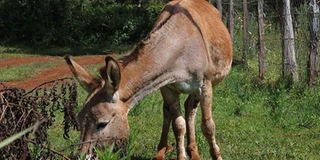Kenya at centre of donkey smuggling racket

A donkey. Animal rights activists want donkeys protected from becoming extinct. PHOTO | FILE | NATION MEDIA GROUP
What you need to know:
- Donkeys remain crucial to rural economies, where they are used to transport food, water, firewood and farm produce.
- Donkey Sanctuary Campaign Manager Simon Pope said every donkey stolen from a dependent family or community in Ethiopia sets in motion a story of broken hopes and poverty.
Kenya has been identified as a conduit for smuggling donkeys from neighbouring countries, according to a new report.
Demand for donkey skin, which is used in China for making traditional medicine, has been blamed for halving Kenya’s donkey population.
Donkeys remain crucial to rural economies, where they are used to transport food, water, firewood and farm produce.
But in China, they are used in production of ejiao, a traditional medicine made from gelatin extracted from boiled donkey hides.
Ejiao was in the past prescribed primarily to supplement lost blood but today it is sought for a range of ailments, from delaying ageing and increasing libido to treating side effects of chemotherapy and preventing infertility, miscarriage and menstrual irregularity.
ABATTOIRS
As demand for ejiao in China soars by the day – fetching around 400USD (Sh40,700) per pound, up from nine USD per pound – Chinese traders have turned to Africa in recent years to meet their demand for donkey skin, a move that has increased theft and cross-border smuggling of the animals in Kenya.
Three Chinese companies have so far opened donkey slaughter houses in the country: The Zilzha Ltd Slaughterhouse in Nakwaalele, Turkana, Goldox donkey slaughterhouse in Mogotio, Baringo, and Star Brilliant Abattoir in Naivasha, Nakuru.
The 2009 census estimated that there were about 1.8 million donkeys in Kenya. But animal rights activists have raised the alarm, saying that since at least 100,000 donkeys are slaughtered each year, they could become extinct.
Moreover, some unscrupulous traders have been killing the animals illegally and passing them off as beef in local butcheries.
PURCHASE
The report released this week by Oxpeckers Investigative Environmental Journalism, and sponsored by The Donkey Sanctuary, tracked the trade route of donkeys being smuggled from Ethiopia and into Kenyan slaughterhouses.
It found that donkeys were being sourced both legally and illegally from Ethiopia.
The donkeys are trucked with no food or water for 1,100km to reach the border post in Moyale.
They are then walked across the border before being trucked again to Goldox slaughterhouse in Baringo or Star Brilliant slaughterhouse.
DEMAND
In Naivasha, Oxpeckers met taxi driver Lawrence Kamau who said he had made “lots of good money” from the Star Brilliant abattoir since it opened in 2012.
“When the abattoirs were opened, people willingly sold their old, injured and excess donkeys. With the surplus donkeys gone, the demand is up by thousands and yet people don’t want to sell any more,” Mr Kamau said.
“The scarcity has bred demand, and demand has bred incentives. The Chinese now pay more for donkeys,” he added.
Mr Kamau said most of the donkeys slaughtered in Kenya are stolen or bought in Ethiopia before being smuggled in.
POVERTY
He says trucks arrive everyday at the Moyale border with donkeys headed for slaughterhouses. There are reports that donkeys are also being sourced from Somalia and Tanzania, owing to the shortage.
Donkey Sanctuary Campaign Manager Simon Pope said every donkey stolen from a dependent family or community in Ethiopia sets in motion a story of broken hopes and poverty.
“It might mean that families cannot afford to put food on the table that night, or that they have to work even harder and longer now that their principal means of earning a living has gone.”





